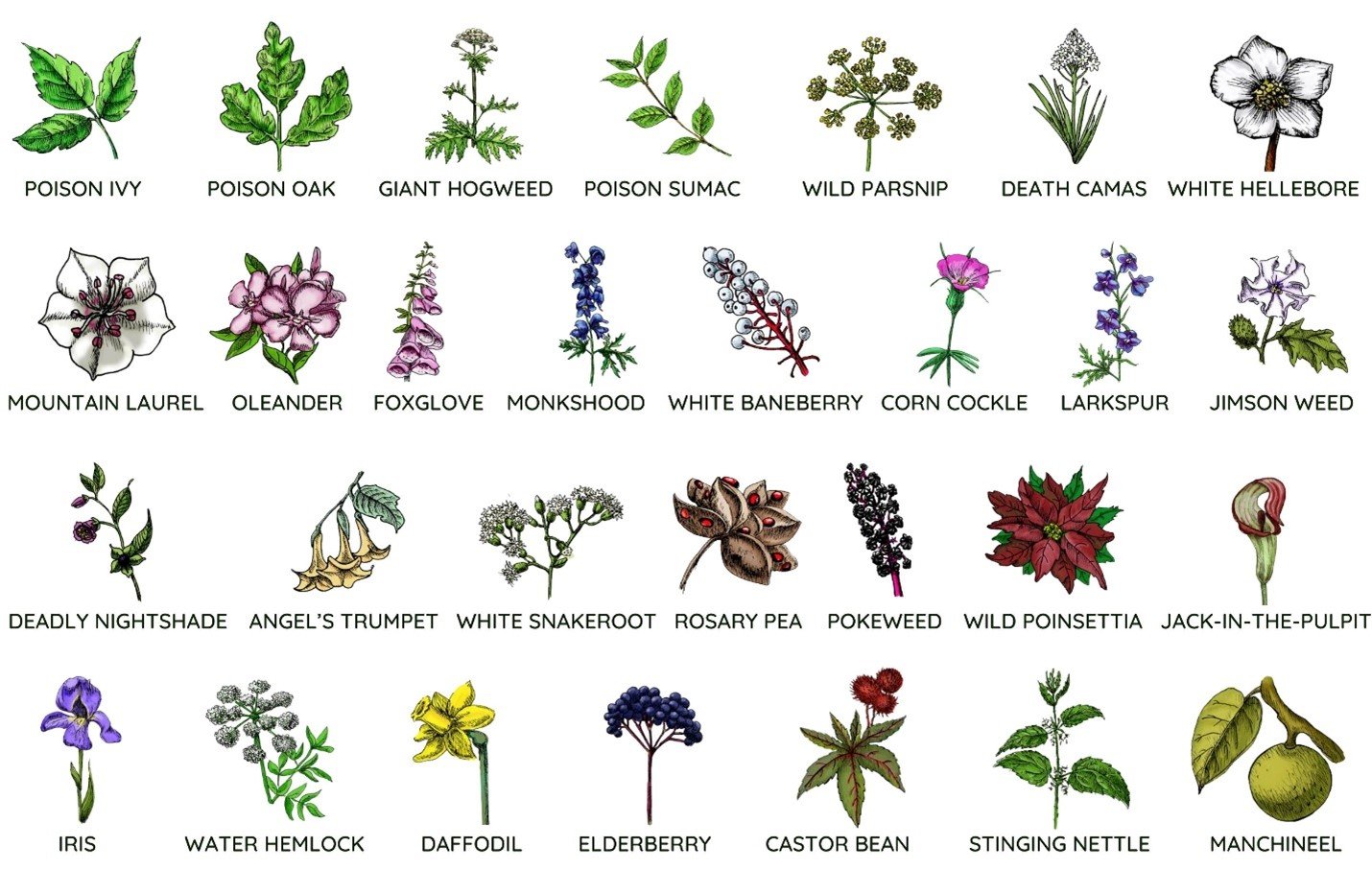Toxic Landscape Plants
In the beauty and serenity of our Arcadia landscapes lurk the hidden danger of toxic plants. Homeowners need to be aware of hazardous plants in their landscapes so they can safeguard children and pets from danger. Here are the actions you can take to ensure their safety:
1. Education and awareness: Familiarize yourself with common toxic plants in your yard and neighborhood. Understand their characteristics, appearance, and potential risks. This knowledge will help you identify and avoid them.
2. Careful plant selection: Prioritize non-toxic plant varieties for your landscaping. Consult with local nurseries or gardening experts to ensure you choose safe and suitable options that won't pose a threat to children or pets.
3. Physical barriers: Install physical barriers like fences or gates to restrict access to areas containing toxic plants. This will prevent curious little explorers or playful pets from coming into direct contact with these potentially harmful specimens.
4. Supervision and guidance: Keep a watchful eye on children and pets while they are in the garden. Supervision can help prevent them from ingesting or interacting with toxic plants unknowingly.
5. Training and obedience: Train pets to obey commands such as "leave it" or "drop it." This can be particularly useful if they have a tendency to chew on or investigate plants during outdoor activities.
6. Proper storage and disposal: Store gardening tools, fertilizers, and pesticides securely, out of reach from children and pets. Dispose of any plant trimmings or fallen leaves in a responsible manner to prevent accidental ingestion.
7. Regular maintenance: Maintain your garden by regularly inspecting and removing any toxic plants that may have sprouted. Promptly address any potential hazards to ensure the safety of your family.
8. Seek professional advice: If you are unsure about the toxicity of a particular plant or need guidance on creating a safe garden environment, consult with a local horticulturist or professional landscaper.
Individuals and pets have varying tolerances to poisonous compounds in plants. The severity of poisoning is also affected by age, weight, general health status, the quantity of plant ingested, and the form of the plant at time of ingestion (i.e., cooked vs. raw, ripe vs. unripe fruit, smoke from burning, etc.).
Some common poisonous plants found in Arcadia are listed in the table below. However, there are over 2000 toxic plants in Arizona. Any landscape plant consumed by a child or pet should be investigated for safety. In addition, beware of toxic plants delivered to your house – often flower bouquets and arrangements will have filler plants that can be toxic (place these where pets and children can’t reach them).
Aloe Vera (Aloe vera) Toxic saponins and anthraquinones cause vomiting, lethargy, diarrhea. The gel is considered edible.
Autumn Crocus (Colchicum autumnale) Colchicine and other alkaloids cause bloody vomiting, diarrhea, shock, multi-organ damage, and bone marrow suppression.
Azaleas (Rhododendron) Entire plant is poisonous. Symptoms of drooling, tears, vomiting, slow pulse, low blood pressure, coma, death.
Carolina Jessamine (Gelsemium Sempervirens) Entire plant extremely toxic. A trace amount can be deadly.
Castor Bean (Ricinus communis) Most toxic plant for humans and pets. Symptoms may take 12-48 hours to appear. Fatal.
Dumbcane (Dieffenbachia) Causes airway swelling and intense burning pain on tongue. Sap can damage eye corneas.
Elephant’s Ear (Caladium hortulanum) Poisonous calcium oxalates
Foxgloves (Digitalis) While a source of pharmaceuticals for humans, the raw plant is extremely toxic to humans, dogs, and cats. A half a gram of dried leaf, or 2 grams of fresh leaf, is fatal to a human.
Hyacinth, Narcissus, Daffodil (Hyacinthus spp. & Narcissus spp.) All parts contain toxic chemical lycorine and may contain toxic calcium oxalate crystals. Induces nausea, vomiting, diarrhea, and stomach discomfort in small amounts.
Hills of Snow (Hydrangea macrophylla) Entire plant, especially the flower buds, is poisonous. Contains the poison hydragin – has similar effects to cyanide.
Jimsonweed (Datura stramonium) Many toxic alkaloids, which cause delirium, tachycardia, photophobia. Can be fatal.
Lantana (Lantana spp.) Toxic Pentacyclic triterpenoids cause vomiting, diarrhea, labored breathing, weakness, leading to liver failure.
Larkspur (Delphinium consolida) Diterpene alkaloids cause constipation, drooling, muscle tremors, convulsions, and cardiac failure.
Lily-of-the-Valley (Convallaria majalis) Poisonous cardenolides cause vomiting, irregular heartbeat, low blood pressure, coma, and seizures.
Mexican Bird of Paradise (Caesalpinia Pulcherrima) Tannins cause gastrointestinal irritation, vomiting, and diarrhea.
Oak (Quercus spp.) Most dangerous in budding and leafing stages when acorns are available. Toxic gallotannins lead to kidney failure.
Oleander (Nerium oleander) Every part of the oleander is toxic, as is smoke from burning it. Contains several poisons affecting the heart and produces server digestive upset.
Texas Mountain Laurel (Sophia secundiflora) All parts of this plant is toxic. Causes drooling, vomiting, tremors, seizures, convulsions, and death.
Water Hemlock (Cicuta maculate) Entire plant is toxic.
Yew (Taxus spp.) The poison taxine cause muscular tremors, dyspnea, and seizures followed by sudden death from acute cardiac failure.
All types of lilies (Easter Lily, Tiger Lily, etc.) are extremely toxic to cats. Both the leaves and flowers are toxic. Causes anorexia, salivation, vomiting, and depression which leads to kidney failure and death within 18 hours.
Wild mushrooms are assumed to be poisonous (only trained experts can correctly identify edible mushrooms). Remove all mushrooms from your yard. Often after heavy rain in Arcadia, mushrooms can sprout overnight. While it is tempting to just kick them, that will just spread spores that will sprout in the future. Using gloves, pull them up by the stems, place them in a plastic bag, then dispose of them in the trash.
There are over 2000 toxic plants in Arizona. Any plant consumed by a child or pet should be investigated for safety.
General symptoms of child and pet poisoning are vomiting, diarrhea, difficulty breathing, abnormal urine (color, odor, frequency), salivation, and weakness.
Additional plants toxic to dogs are cats are cherry tree, coral plant, coriander, elderberry, eucalyptus, flame tree, holly, honeysuckle, English ivy, jasmine, marijuana, oak, periwinkle, poinsettia, potato shoots, privet, red maple, snowdrop, sweat pea, tobacco, and wisteria.
Additional foods toxic to dogs and cats are almonds, balsam pears, avocados, apricots, coffee (brewed, beans, or grounds), tea bags, chocolate, onions (and onion powder), raisins, currants, pear and peach kernels, grapes, macadamia nuts, and yeast dough. Medications such as acetaminophen and ibuprofen are poisonous, as well as car antifreeze – and, this should go without saying, pesticides (including rat, mouse, and snail poisons). Gum and mints with xylitol (artificial sweetener).
Be advised that the consumption of any plant material may cause vomiting and gastrointestinal upset for dogs and cats. Plants listed as either non-toxic, or potentially toxic with mild GI upset as their symptoms are not expected to be life-threatening to your pets. Review the list of toxic and non-toxic plants at the ASPCA website.
In Case Of Emergency
The procedures below are general guidelines for suspected poisoning emergencies. Discuss with your doctors and veterinarians for specific guidance for your situation. Do not use any of the guidelines below or on websites to attempt to self-treat; if a toxic substance has been consumed, seek medical or veterinary care immediately.
Program the phone numbers given below into your phone contacts. Do not wait for a person, or a pet, to look for feel sick before calling poison control. Save or gather parts of the plant (stems, leaves, and especially flowers) for identification (if vomiting has occurred, collect a sample of vomit).
People: Call the Poison Control right away at 1-800-222-1222. Remove any parts of the plant from the mouth. Give a small amount of water to drink. Wash any skin exposed to the plant with soap and water right away. Remove any clothing that has been in contact with the plant. Any plant can cause choking or an unexpected reaction – if this occurs, call 911 immediately.
Pets: Call the ASPCA Animal Poison Control Center 24-hr emergency hotline at 1-888-426-4435 or the Pet Poison Helpline at 1-855-764-7661. Consulting fees will be charged. Prevent the pet from eating or contacting any more of the plant, food, or medication. Only wash your pet if advised to do so by a vet. In your pet starts to choke or shows an unexpected reaction, call a 24-hour Veterinary hospital immediately (look one up now).
Do not delay medical care to try and identify if a plant or substance is poisonous – get the patient medical attention as soon as possible.
More Information:
Poisonous Plants (Poster) – Arizona Poison and Drug Information Center
https://azpoison.com/sites/default/files/u3/poisonous_plants_web_0.pdf
Poisonous Landscape Plants, Yavapai County Cooperative Extension
https://extension.arizona.edu/poisonous-landscape-plants
22 Poisonous Plants In Arizona
https://www.progardentips.com/poisonous-plants-in-arizona/
12 Deadliest Garden Plants
https://roadrunnerflorist.com/12-deadliest-garden-plants/
Poisonous Substances, Foods, and Plants; Ahwatukee Animal Care Hospital
https://www.ahwatukeeanimalcare.com/poisonous-plants.pml
Poisonous Plants; ASCPA
https://www.aspca.org/pet-care/animal-poison-control/toxic-and-non-toxic-plants
Oleander Bushes



